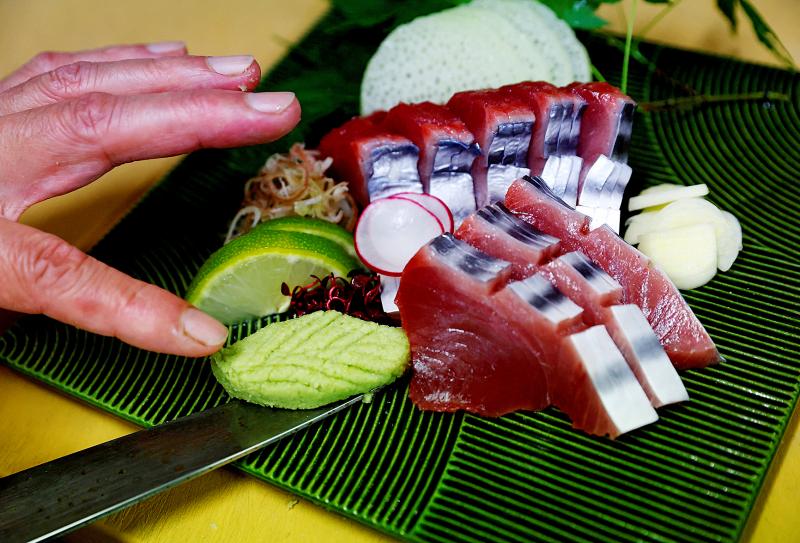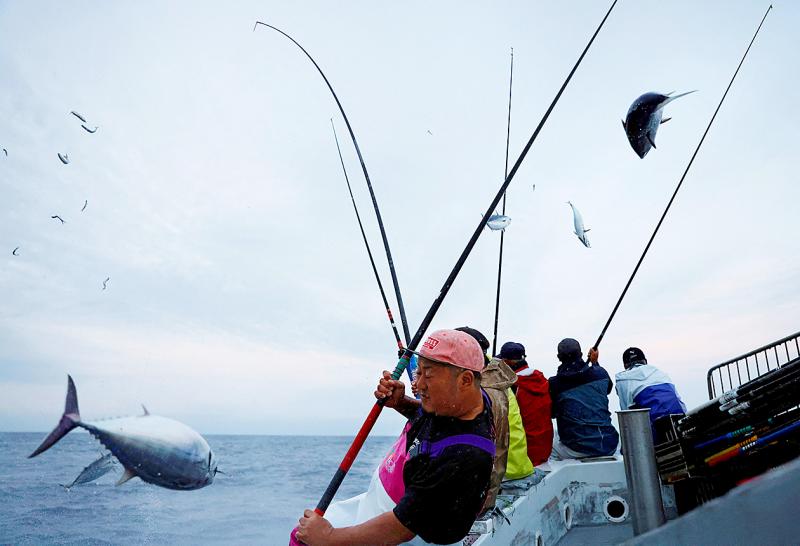For half a century, Takeo Nakajo has been catching katsuo, or skipjack tuna — indispensable in Japanese cuisine whether eaten raw, dried or used as a base for the broth.
But he and other fishermen in Kure, in Kochi prefecture in southwest Japan, have seen something worrying in the past two years — an unprecedented number of unusually fatty katsuo.
While heavier katsuo means more money, locals and experts say it indicates climate change and a risk for katsuo numbers already under threat due to growing demand and overfishing.

Photo: Reuters
“The fatty katsuo must have something to do with the water temperature,” said the 70-year-old Nakajo. “I have a sense of urgency thinking what if katsuo doesn’t come to the bay some day.”
Noriaki Ito, the head chef at a century-old restaurant Tsukasa in Kochi City, said he too had “never seen such fatty katsuo during this season of the year.”
This is worrying as changes in the sea and climate have already wiped out some other fish “including a shellfish called chambara-gai that used to be Kochi’s speciality,” Ito added.

Photo: Reuters
Originally from tropical waters, some Pacific katsuo migrate northward on a warm ocean current every spring, making Kochi’s arc-shaped bay a fertile fishing ground.
The average surface temperature of the bay in winter has risen by 2 degrees Celsius in the four decades to 2015, local fisheries lab data shows, and the fatter katsuo may be due to ample prey in the warmer sea.
But longer term, this warming may prevent mineral-rich water from rising to the surface, resulting in a drop in plankton and smaller fish to feed on, leading to fewer katsuo, said Hiroyuki Ukeda, an agroscientist and vice president of Kochi University.
This comes as Japan’s aging population is threatening the sustainability of local fishing and related businesses such as the production of dried and fermented katsuo, and wasabi horseradish — an eye-watering condiment tucked under fish in a piece of sushi.
In Kure, a district in Nakatosa town, many fishermen have gone out of business in the past three decades, said Takahiro Tanaka, a fourth-generation owner of a fishmonger who calls himself a “katsuo sommelier.”
“We can distinguish different tastes of katsuo, just like ordinary French farmers may savor subtleties of wine ... this place might be one of Japan’s last communities where katsuo is part of the daily culture,” he added.
“But without fishers, this won’t last,” Tanaka said.
Fisherman Nakajo also rued the aging community and fewer successors. “I asked my grandson if he would take over, but he’s now studying to work at a government office,” Nakajo said.
SUSHI CULTURE AT RISK
Overfishing has already hit catch numbers and dealt a blow to the fishermen in Kochi who have stuck to traditional single pole fishing methods versus large-scale seine fishing across the western Pacific.
Government data shows catch numbers in Kochi are only at a quarter of their 1980s peak.
“We have observed a catastrophic decline in landings over the last 10 years or so,” said Ukeda.
“A growing number of people fear we may no longer be able to eat katsuo in the near future if things continue like this.”
Production of katsuobushi, dried and fermented katsuo, often used as a shaved condiment over traditional Japanese dishes or as a broth base, is already suffering.
The number of katsuobushi manufacturers in Kochi has plunged from dozens some 40 years ago to only a few, said Taichi Takeuchi, who runs one in the town of Usa.
“I’m really unsure if we can continue this,” said Takeuchi.

Following the shock complete failure of all the recall votes against Chinese Nationalist Party (KMT) lawmakers on July 26, pan-blue supporters and the Chinese Communist Party (CCP) were giddy with victory. A notable exception was KMT Chairman Eric Chu (朱立倫), who knew better. At a press conference on July 29, he bowed deeply in gratitude to the voters and said the recalls were “not about which party won or lost, but were a great victory for the Taiwanese voters.” The entire recall process was a disaster for both the KMT and the Democratic Progressive Party (DPP). The only bright spot for

Water management is one of the most powerful forces shaping modern Taiwan’s landscapes and politics. Many of Taiwan’s township and county boundaries are defined by watersheds. The current course of the mighty Jhuoshuei River (濁水溪) was largely established by Japanese embankment building during the 1918-1923 period. Taoyuan is dotted with ponds constructed by settlers from China during the Qing period. Countless local civic actions have been driven by opposition to water projects. Last week something like 2,600mm of rain fell on southern Taiwan in seven days, peaking at over 2,800mm in Duona (多納) in Kaohsiung’s Maolin District (茂林), according to

Aug. 11 to Aug. 17 Those who never heard of architect Hsiu Tse-lan (修澤蘭) must have seen her work — on the reverse of the NT$100 bill is the Yangmingshan Zhongshan Hall (陽明山中山樓). Then-president Chiang Kai-shek (蔣介石) reportedly hand-picked her for the job and gave her just 13 months to complete it in time for the centennial of Republic of China founder Sun Yat-sen’s birth on Nov. 12, 1966. Another landmark project is Garden City (花園新城) in New Taipei City’s Sindian District (新店) — Taiwan’s first mountainside planned community, which Hsiu initiated in 1968. She was involved in every stage, from selecting

As last month dawned, the Democratic Progressive Party (DPP) was in a good position. The recall campaigns had strong momentum, polling showed many Chinese Nationalist Party (KMT) lawmakers at risk of recall and even the KMT was bracing for losing seats while facing a tsunami of voter fraud investigations. Polling pointed to some of the recalls being a lock for victory. Though in most districts the majority was against recalling their lawmaker, among voters “definitely” planning to vote, there were double-digit margins in favor of recall in at least five districts, with three districts near or above 20 percent in